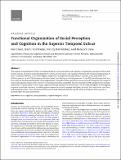| dc.contributor.author | Deen, Ben | |
| dc.contributor.author | Koldewyn, Kami | |
| dc.contributor.author | Kanwisher, Nancy | |
| dc.contributor.author | Saxe, Rebecca R. | |
| dc.date.accessioned | 2016-05-12T00:20:17Z | |
| dc.date.available | 2016-05-12T00:20:17Z | |
| dc.date.issued | 2015-06 | |
| dc.identifier.issn | 1047-3211 | |
| dc.identifier.issn | 1460-2199 | |
| dc.identifier.uri | http://hdl.handle.net/1721.1/102458 | |
| dc.description.abstract | The superior temporal sulcus (STS) is considered a hub for social perception and cognition, including the perception of faces and human motion, as well as understanding others' actions, mental states, and language. However, the functional organization of the STS remains debated: Is this broad region composed of multiple functionally distinct modules, each specialized for a different process, or are STS subregions multifunctional, contributing to multiple processes? Is the STS spatially organized, and if so, what are the dominant features of this organization? We address these questions by measuring STS responses to a range of social and linguistic stimuli in the same set of human participants, using fMRI. We find a number of STS subregions that respond selectively to certain types of social input, organized along a posterior-to-anterior axis. We also identify regions of overlapping response to multiple contrasts, including regions responsive to both language and theory of mind, faces and voices, and faces and biological motion. Thus, the human STS contains both relatively domain-specific areas, and regions that respond to multiple types of social information. | en_US |
| dc.description.sponsorship | David & Lucile Packard Foundation | en_US |
| dc.description.sponsorship | National Science Foundation (U.S.). Graduate Research Fellowship | en_US |
| dc.description.sponsorship | National Science Foundation (U.S.) (CCF-1231216) | en_US |
| dc.language.iso | en_US | |
| dc.publisher | Oxford University Press | en_US |
| dc.relation.isversionof | http://dx.doi.org/10.1093/cercor/bhv111 | en_US |
| dc.rights | Creative Commons Attribution Non-Commercial License | en_US |
| dc.rights.uri | http://creativecommons.org/licenses/by-nc/4.0/ | en_US |
| dc.source | Oxford University Press | en_US |
| dc.title | Functional Organization of Social Perception and Cognition in the Superior Temporal Sulcus | en_US |
| dc.type | Article | en_US |
| dc.identifier.citation | Deen, Ben, Kami Koldewyn, Nancy Kanwisher, and Rebecca Saxe. “Functional Organization of Social Perception and Cognition in the Superior Temporal Sulcus.” Cerebral Cortex 25, no. 11 (June 5, 2015): 4596–4609. | en_US |
| dc.contributor.department | Massachusetts Institute of Technology. Department of Brain and Cognitive Sciences | en_US |
| dc.contributor.department | McGovern Institute for Brain Research at MIT | en_US |
| dc.contributor.mitauthor | Deen, Ben | en_US |
| dc.contributor.mitauthor | Koldewyn, Kami | en_US |
| dc.contributor.mitauthor | Kanwisher, Nancy | en_US |
| dc.contributor.mitauthor | Saxe, Rebecca R. | en_US |
| dc.relation.journal | Cerebral Cortex | en_US |
| dc.eprint.version | Final published version | en_US |
| dc.type.uri | http://purl.org/eprint/type/JournalArticle | en_US |
| eprint.status | http://purl.org/eprint/status/PeerReviewed | en_US |
| dspace.orderedauthors | Deen, Ben; Koldewyn, Kami; Kanwisher, Nancy; Saxe, Rebecca | en_US |
| dspace.embargo.terms | N | en_US |
| dc.identifier.orcid | https://orcid.org/0000-0003-2377-1791 | |
| dc.identifier.orcid | https://orcid.org/0000-0003-3853-7885 | |
| dc.identifier.orcid | https://orcid.org/0000-0002-3812-4258 | |
| mit.license | PUBLISHER_CC | en_US |
| mit.metadata.status | Complete | |
